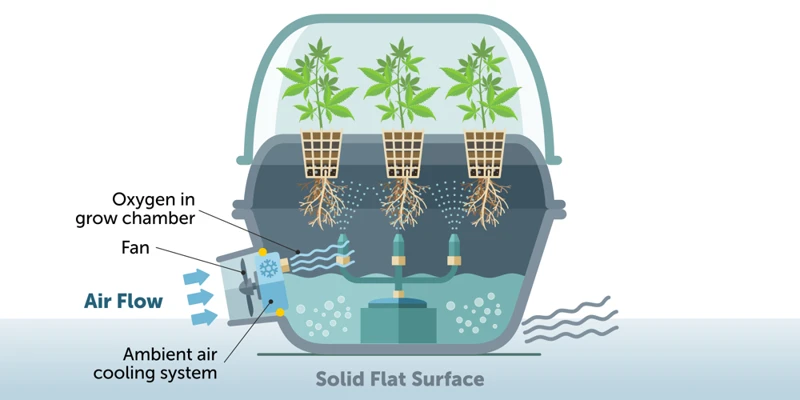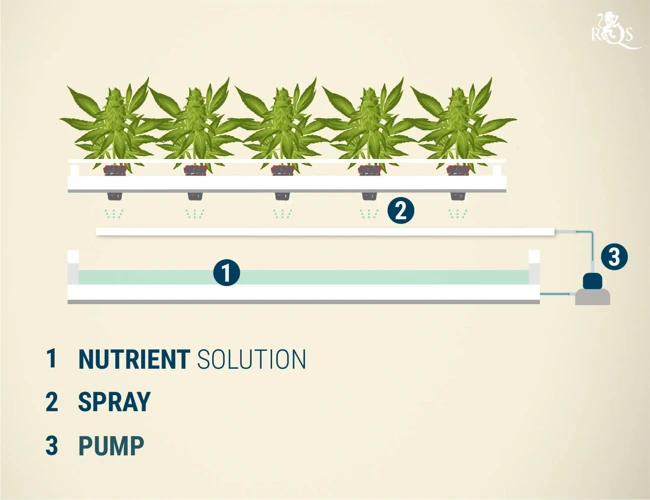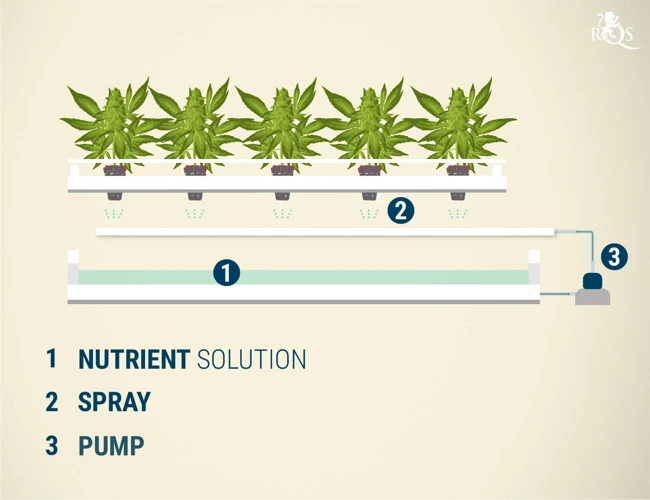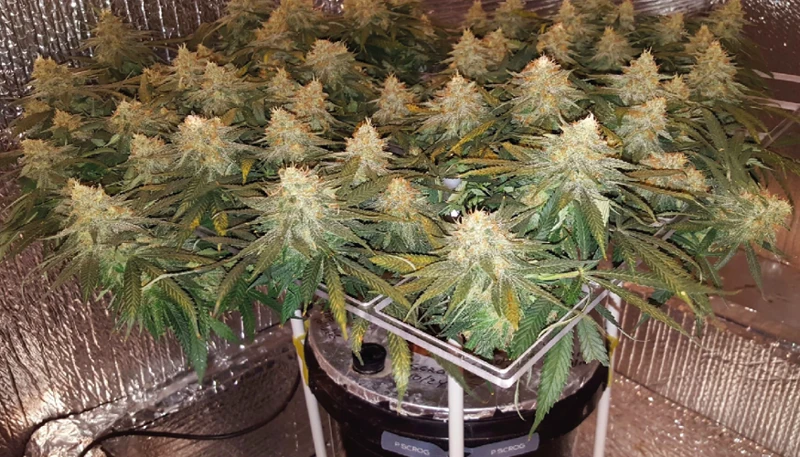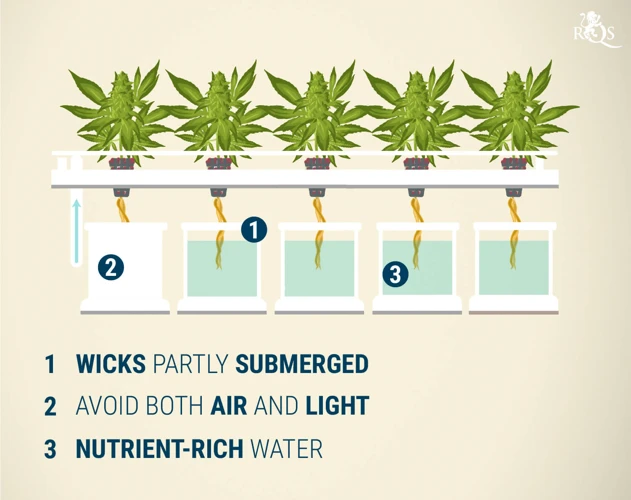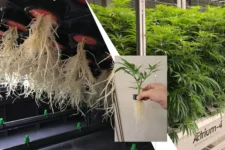
A Beginner’s Guide to Aeroponics for Cannabis Growing
As cannabis growing becomes more popular, growers are constantly experimenting with new techniques to increase yield and growth speed. One such technique is aeroponics, but what exactly is it and how does it work? In this article, we will explore the advantages of using aeroponics for cannabis growing, how to set up your own system, planting cannabis in your aeroponic system, and troubleshooting common issues. Whether you’re a seasoned grower or just starting out, aeroponics may be the solution you’ve been searching for. So, let’s dive in and discover the world of aeroponics for cannabis growing.
What is Aeroponics?
Contents
As the demand for cannabis continues to grow, so does the need for innovative and efficient cultivation methods. One such method is aeroponics, a system that allows for higher yields and faster plant growth. But what exactly is aeroponics? Simply put, it is a technique of growing plants in the air with a highly oxygenated nutrient mist rather than in soil or water. In this section, we will explore the history and mechanics behind aeroponics.
A Brief History of Aeroponics
Aeroponics is a relatively new technique that has gained popularity in recent years. It involves growing plants in an environment where the roots are suspended in air and sprayed with a nutrient-rich mist. This innovative method has a fascinating history.
Year
Event
1910s
In 1911, a man by the name of Frederick Gericke was the first to experiment with hydroponics, a cultivation method where plants are grown without soil. By the 1930s, he had developed and patented a method of growing plants using aeroponics, which he referred to as “aerial culture.”
1940s
In the 1940s, two more researchers, Richard Stoner and G. Wesley Smith, began to experiment with aeroponics. They built an aeroponic system for growing peanut plants and found that the roots developed well and the plants produced high yields. This was a significant discovery and laid the foundation for modern-day aeroponics.
1980s
In the 1980s, NASA began exploring the use of aeroponics for growing plants in space. This was a challenging task as there was no gravity to hold the water and nutrients around the roots. However, they were successful in developing an aeroponic system that could sustain plant growth in space.
Present Day
Today, aeroponics is a popular method for growing a wide variety of plants, including cannabis. Its popularity stems from its ability to produce higher yields and faster growth rates than traditional cultivation methods. Aeroponic systems have also proven to be water and nutrient-efficient, making them a sustainable choice for cannabis farmers.
The development of aeroponics has come a long way since its inception in the early 1900s. Its success in commercial cannabis cultivation has made it a method worth exploring for many cultivators.
How Aeroponics Works
In Aeroponics, the roots of plants are suspended in the air and misted with a nutrient solution. This allows for maximum oxygenation and nutrient absorption, leading to faster and healthier plant growth.
The Aeroponic Setup: An Aeroponic setup typically consists of a reservoir, pump, and spray nozzles. The reservoir holds the nutrient solution, while the pump pushes it through the spray nozzles. The nozzles create a fine mist that gently coats the roots of the plants.
Oxygenation: Since the roots are suspended in the air in an Aeroponic system, they have access to more oxygen than in traditional soil-based systems. This extra oxygen promotes healthy root growth and helps prevent root rot.
Nutrient Absorption: In an Aeroponic setup, the nutrient solution is delivered directly to the roots in the form of a mist. This allows for more efficient nutrient absorption, as the roots don’t have to search through soil for nutrients.
Plant Growth: With the increased oxygenation and nutrient absorption, plants grown in Aeroponic systems typically experience faster growth and higher yields. The controlled environment of the system also allows for precise management of pH and nutrient levels, further optimizing plant growth.
Efficiency: Aeroponic systems use significantly less water and nutrients than traditional soil-based systems, making them a more efficient and sustainable option for cannabis growing.
Aeroponics is a cutting-edge growing method that offers many advantages over traditional growing methods. Its unique setup allows for optimal oxygenation and nutrient absorption, resulting in faster growth and higher yields. Plus, its efficiency and sustainability make it an attractive option for growers looking to minimize their environmental impact.
Advantages of Using Aeroponics for Cannabis Growing
Cannabis growers are constantly seeking innovative ways to maximize their yields and speed up their growth cycles. One method that has gained significant traction in recent years is aeroponics. This cutting-edge technique of growing plants in a nutrient-rich mist has multiple benefits for cannabis cultivators, including higher yields, faster growth, and greater water and nutrient efficiency. In this section of the article, we will delve deeper into these advantages and explore how aeroponics can revolutionize your cannabis growing process.
Higher Yield
Aeroponics for cannabis growing has numerous advantages, and one of the major ones is the potential for a higher yield than other growing methods. Here are a few reasons why:
- Increased Oxygenation: In an aeroponic system, the cannabis roots are suspended in the air and misted with water and nutrients. This allows for excellent oxygenation of the roots, which leads to faster growth and bigger yields.
- Faster Nutrient Absorption: In soil or hydroponic systems, nutrients need to be broken down by microbes in the soil or water before they can be absorbed by the plant. In aeroponics, the nutrients are already broken down into a fine mist, which allows for faster and more efficient absorption by the plant.
- No Nutrient Lockout: In soil or hydroponics, it’s easy for the plants to become nutrient-locked, meaning they can no longer absorb certain nutrients. This can lead to stunted growth and lower yields. In an aeroponic system, nutrients are delivered directly to the roots, greatly reducing the risk of nutrient lockout.
- Optimal Growing Conditions: Aeroponic systems allow for very precise control of environmental factors like temperature, humidity, and CO2 levels, which means you can create the perfect growing conditions for your cannabis plants. This can result in faster growth and bigger yields.
- Reduced Risk of Disease: Because the cannabis roots are suspended in the air and not sitting in soil, there is a reduced risk of soil-borne diseases like root rot or fungus. This means you can grow cannabis plants closer together without worrying as much about disease spreading.
While there are other factors that can impact yield, such as strain genetics and growing techniques, aeroponics offers unique benefits that can help you achieve your goals of a higher yield.
Faster Growth
One of the major advantages of using Aeroponics for cannabis growing is the faster growth of the plants. In an aeroponic setup, the roots of the plants are suspended in air and misted with a nutrient-rich solution. This allows for the roots to receive a high concentration of oxygen which in turn promotes faster growth and root development.
Compared to traditional soil-based growing methods, aeroponics can result in up to 50% faster growth rates. The nutrient-rich solution and high oxygen levels provided to the plants in an aeroponic system allow them to absorb nutrients more efficiently which leads to accelerated growth.
Additionally, the absence of soil in an aeroponic system means that plants can grow closer together without competing for nutrients. This means that a larger number of plants can be grown in a smaller space, further increasing the yield potential and growth rate of the plants.
Another factor that contributes to faster growth in an aeroponic setup is the ability to easily control environmental variables such as temperature, humidity, and lighting. This ensures that the plants receive optimal conditions for growth at all times.
Faster growth is a major advantage of using aeroponics for cannabis growing. With the ability to control environmental variables and provide a nutrient-rich solution to the roots, growers can expect significantly faster growth rates and increased yield potential.
| Advantages of Aeroponics for Cannabis Growing: Faster Growth |
|:—:|
| Faster growth rates compared to soil-based methods |
| Higher oxygen levels promotes faster root development |
| Efficient nutrient absorption leads to accelerated growth |
| Increased yield potential due to plants growing closer together |
| Environmental variables can be easily controlled for optimal growth conditions |
Water and Nutrient Efficiency
One of the significant advantages of using an aeroponic system for cannabis growth is its superior efficiency in water and nutrient usage. With aeroponics, marijuana roots are suspended in the air and misted with a nutrient-rich solution at regular intervals, drastically reducing the amount of water and nutrients needed.
Here are the key benefits of water and nutrient efficiency in an aeroponic system:
- Reduced Water Usage: In traditional cannabis-growing methods, much of the water applied to the soil or hydroponic system easily evaporates, leaving less water for the plant to absorb. Aeroponics, on the other hand, applies water directly to the plant roots, causing only minimal evaporation. As a result, water usage is considerably reduced, allowing for more effective use of limited water resources.
- Less Nutrient Waste: Traditional hydroponic solutions can end up wasting nutrients as they flow past the plant roots and are not absorbed. In an aeroponic system, the nutrient mist is directly targeted to the roots, allowing for maximum absorption and reducing nutrient waste.
- Better Nutrient Absorption: Aeroponic systems provide a high level of oxygenation to the roots, which allows for better nutrient absorption. The nutrient mist can be formulated precisely, ensuring that the plants receive the exact nutrients they need while minimizing nutrient waste.
- Improved Plant Growth: By reducing water and nutrient waste and providing better nutrient absorption, aeroponic systems allow for more extensive and healthier root systems. Healthy roots lead to efficient nutrient uptake, and the result is faster growth and higher yields for your cannabis plants.
Water and nutrient efficiency in an aeroponic system not only benefits the environment but also provides significant benefits for cannabis growers. With less water and fewer nutrients needed, the cost of cannabis production is reduced, and the quality of the final product is improved.
Setting up Your Aeroponic System
Now that you know the advantages of using aeroponics for growing cannabis, it’s time to set up your own aeroponic system. This may seem daunting at first, but with the right guidance, you can create a highly effective system that will give you a higher yield and faster growth than traditional growing methods. In this section, we will cover everything you need to know about choosing the right aeroponic setup, setting up your system properly, the importance of lighting, and selecting the right nutrients for your plants. By the end of this section, you’ll be ready to start growing your cannabis plants in an aeroponic system.
Choosing the Right Aeroponic Setup
When choosing the right aeroponic setup for your cannabis growing needs, there are a few important factors to consider. Here are some key points to keep in mind:
- Budget: Aeroponic systems can vary in price, from basic setups to more complex and expensive options. Determine what your budget is before making a decision.
- Size: Consider the size of your grow space and how many plants you plan to grow. Choosing an aeroponic system that can accommodate your needs is important for achieving optimal results.
- Material: Aeroponic systems can be made of different materials, such as plastic, PVC, or metal. Each material has its advantages and disadvantages, so choose carefully based on the conditions in your grow space, the type of cannabis strain you plan to grow, and your budget.
- Number of plant sites: The number of plant sites your aeroponic system has will determine how many plants you can grow at once. Consider the size of your grow space and how many plants you plan to grow before choosing a system.
- Pump: A reliable pump is essential for the proper functioning of your aeroponic system. Choose a pump that is powerful enough to handle the water and nutrient solution and that has good reviews from other cannabis growers.
- Misting nozzles: The misting nozzles are what spray the nutrient solution onto the plant roots. It’s important to choose high-quality misting nozzles that are durable and easy to clean, to avoid clogs or leaks that could harm your plants.
Remember to factor in your budget, grow space size, material, number of plant sites, pump quality, and misting nozzle durability when choosing the right aeroponic setup for your cannabis growing needs. A little extra research and investment upfront can go a long way in maximizing your yield and achieving the fastest growth possible.
Setting Up Your Aeroponic System
When it comes to setting up your aeroponic system, there are certain things you need to consider to ensure that your plants have a healthy environment to grow in. Here are some steps you can take:
| Step | Description |
|---|---|
| 1 | Choose your system: There are various types of aeroponic systems available in the market, each with its own set of advantages and disadvantages. It’s important to choose the system that best suits your needs and budget. |
| 2 | Prepare your growing medium: Unlike traditional growing methods, aeroponics doesn’t use soil as the growing medium. Instead, it uses a porous material like rockwool, perlite or coconut coir. These materials help to facilitate the flow of oxygen and nutrient-rich water to the plant roots. |
| 3 | Install your misting nozzles: The misting nozzles are a crucial part of your aeroponic system. They are responsible for creating the fine mist of nutrient-rich water that is sprayed on the plant roots. It’s important to ensure that the nozzles are installed at the proper height and angle, and that they are evenly spaced to provide adequate coverage to all the plants. |
| 4 | Set up your nutrient reservoir: Your nutrient reservoir is where the nutrient solution is stored. It needs to be large enough to hold the required amount of nutrient solution and should be made from a non-toxic material like food-grade plastic. It’s important to keep the reservoir covered to prevent evaporation and contamination. |
| 5 | Adjust your pH and EC levels: The pH and EC levels of your nutrient solution are crucial to the health of your plants. You need to ensure that they are within the optimal range for cannabis: pH levels between 5.5-6.5 and EC levels between 1.5-2.5 mS/cm. |
| 6 | Install your air pump: The air pump is responsible for delivering oxygen to the roots of your plants. It needs to be powerful enough to create a consistent flow of bubbles in your nutrient solution. |
| 7 | Set up your lighting: Adequate lighting is essential for the growth and development of your cannabis plants. You need to ensure that your plants receive at least 16-18 hours of light per day during the vegetative phase and 12 hours of light per day during the flowering phase. |
These steps will help you to set up your aeroponic system for growing cannabis. By taking the time to properly prepare your system, you’ll be able to provide your plants with the ideal growing environment and maximize your yield.
The Importance of Lighting
Proper lighting is crucial for the success of cannabis growth in an aeroponic system. Here are a few things to keep in mind when choosing and setting up your lighting system:
- Type of Light: There are many types of lighting options available for indoor cannabis cultivation, including HPS (high-pressure sodium), LED (light-emitting diode), and fluorescent lights. Each has its own set of advantages and disadvantages, so it’s important to research which type will work best for your specific setup and budget.
- Light Distance: The distance between the light and the plants is also important. Plants that are too close to the light can experience light burn, while plants that are too far away may not receive enough light to grow properly. Generally, lights should be placed at least 12-18 inches away from the canopy of the plants, but this can vary depending on the type of light being used.
- Light Schedule: Cannabis plants require a specific light schedule to thrive. During the vegetative stage, plants typically require 18 hours of light and 6 hours of darkness each day. During the flowering stage, this is usually adjusted to 12 hours of light and 12 hours of darkness. It’s important to follow this schedule closely to ensure optimal growth and development.
- Light Intensity: The intensity of the light is also crucial for optimal plant growth. The appropriate intensity varies depending on the stage of growth the plant is in. During the vegetative stage, the intensity can be lower, around 400-600 µmol/m²/s, while during flowering, the intensity should be increased to around 600-800 µmol/m²/s.
- Light Spectrum: Different wavelengths of light affect plant growth in different ways. Blue light, for example, is essential for vegetative growth, while red light is more important during the flowering stage. Many LED grow lights are designed to provide a full spectrum of light, which is ideal for cannabis cultivation.
By paying attention to these key factors, you can ensure that your cannabis plants receive the proper lighting they need to grow and thrive in an aeroponic system.
Choosing the Right Nutrients
When it comes to growing cannabis using aeroponics, choosing the right nutrients is crucial for achieving optimal yields and faster growth. Without the right balance of nutrients, your plants could suffer from nutrient deficiencies or toxicities, both of which can stunt growth and decrease yields. Here are some important factors to consider when choosing the right nutrients for your aeroponic system:
| Factor | Consideration |
|---|---|
| Nutrient Ratios | Cannabis requires different ratios of nutrients at different stages of growth. During the vegetative stage, plants need higher levels of nitrogen, whereas during the flowering stage, plants require higher levels of phosphorus and potassium. Make sure to choose a nutrient solution that is specifically formulated for cannabis. |
| pH balance | The pH level of your nutrient solution is also crucial for proper nutrient absorption by your plants. The ideal pH range for cannabis grown in aeroponics is between 5.5 and 6.5. Make sure to monitor and adjust the pH of your nutrient solution regularly to ensure the best results. |
| Organic vs. Synthetic | You’ll also need to choose between an organic or synthetic nutrient solution. Organic nutrient solutions can provide a more natural taste and aroma to your cannabis, but can also be more complex to use and may require more frequent changing of the reservoir. Synthetic nutrient solutions, on the other hand, are typically easier to use and can provide more precise control over nutrient levels, but may not produce the same nuanced flavor and aroma as organic solutions. |
| Brand reputation | It’s also important to choose a nutrient solution from a reputable brand. Look for products that have been tested and proven to work well for cannabis growers. You may also want to read reviews from other growers to get an idea of the efficacy of different nutrient solutions. |
By taking these factors into account when choosing the right nutrient solution for your cannabis aeroponic system, you’ll be able to give your plants the precise balance of nutrients they need for optimal growth and yields. Don’t overlook the importance of this step in setting up your aeroponic system for success.
Planting Cannabis in Your Aeroponic System
Now that your aeroponic system is set up, it’s time to start planting your precious cannabis. Planting is the crucial step in any growing process, and an aeroponic system provides an advantageous environment for cannabis growth. Whether starting from seed or transplanting clones, aeroponics can deliver optimal results. In this section, we will discuss the various methods of planting cannabis in your aeroponic system, from starting seeds to transplanting clones, and maintenance tips for keeping your plants healthy and vibrant. Let’s delve into the world of planting cannabis in an aeroponic system.
Starting Seeds in an Aeroponic System
When starting cannabis seeds in an aeroponic system, there are a few steps you should follow to ensure success.
Step 1: Soak Seeds
Soak your cannabis seeds in water for about 24 hours before introducing them to the aeroponic system. This will help activate the seeds and increase the chances of successful germination.
Step 2: Prepare Net Cups
Fill your net cups with your growing medium of choice, such as rockwool or hydroton. Make sure the medium is moist before placing the seeds into the cups.
Step 3: Plant Seeds
Using tweezers or clean hands, carefully plant the soaked seeds into the growing medium in the net cups. Make sure the seeds are covered with enough medium to hold them in place.
Step 4: Place in System
Carefully place the net cups into the aeroponic system, making sure the roots are suspended in the nutrient-rich mist. Be sure to label your net cups with the strain and planting date.
Step 5: Monitor and Adjust
Monitor the system closely to ensure the seeds are receiving enough nutrients and proper environmental conditions. Adjust as necessary by adjusting nutrient levels, light levels, and environmental conditions to ensure healthy growth.
These steps will help give your cannabis seeds the best chance at sprouting and growing into healthy plants in your aeroponic system.
Transplanting Clones into an Aeroponic System
When transplanting clones into an aeroponic system, it’s important to take specific steps to ensure they adjust well to their new environment. Here are some steps that can be followed:
- Prepare the clones: Before transplanting, prepare the clones by ensuring that they are well-rooted and healthy. Also, avoid exposing them to direct sunlight or extreme temperatures as this can cause stress and slow down their growth.
- Apply rooting hormone: To improve the chances of successful transplanting, consider applying rooting hormone to the clones. This will help stimulate root growth and ensure that the clones establish themselves in the aeroponic system.
- Place clones carefully: When placing the clones in the aeroponic system, make sure to handle them with care to avoid damaging any of their root system. Slowly lower them into the system and place them in the designated holes or slots for each plant.
- Monitor and adjust: It’s important to monitor the clones closely in the first few days after transplanting to ensure that they are adjusting well. Keep an eye on their growth and adjust any environmental factors that may be affecting their growth.
- Maintain nutrient and pH levels: As with any aeroponic system, proper maintenance of nutrient and pH levels is key to success. Make sure to monitor and adjust these levels as necessary to ensure that your clones are getting the necessary nutrients to grow and thrive in the system.
- Provide ample lighting: Finally, make sure that your clones are getting enough lighting to thrive. Consider installing grow lights or natural lighting sources to ensure they are getting the necessary amount of light for photosynthesis to occur.
Following these steps can help ensure that your clones will adjust and thrive in your aeroponic system. Remember to monitor and adjust factors that may be affecting their growth, such as nutrient levels, lighting, and pH levels, in order to achieve the best results.
Maintaining Your Aeroponic System
Proper maintenance of your aeroponic system is crucial for the success of your cannabis plants. Here are some important steps to follow to keep your system in tip-top shape:
- Check and adjust pH levels: Cannabis plants require a pH range of 5.5 to 6.5 for optimum growth. Use a pH meter to regularly check the pH levels of your nutrient solution and adjust as needed with pH up or down solutions.
- Cleanliness is key: Keeping your system clean is essential for preventing the growth of harmful bacteria and ensuring the health of your plants. Regularly clean your aeroponic nozzles, tubing, and reservoir with a mild bleach solution or a specialized hydroponic cleaning solution.
- Monitor nutrient levels: Your plants require specific nutrients at different stages of growth. Regularly check the nutrient levels of your solution and adjust as needed. Overfeeding or underfeeding can harm your plants.
- Check water levels: Your plants rely on a consistent water supply. Monitor the water levels in your reservoir and refill as needed to maintain the proper water level for your plants.
- Trimming and pruning: Keeping your plants trimmed and pruned allows for better air circulation and promotes healthier growth. Regularly trim off any yellow or dying leaves and prune excess branches to encourage stronger growth.
- Check for pests: Regularly inspect your plants for any signs of pests, such as spider mites or aphids. If you detect any pests, take immediate action to eliminate the infestation and prevent further damage to your plants.
- Regular system checks: Set a regular schedule for checking all components of your aeroponic system. This ensures that any potential issues are caught early and resolved before they become more serious.
Maintaining your aeroponic system is a crucial part of ensuring your cannabis plants grow to peak health and yield. With proper care and attention, your cannabis crop can thrive in an aeroponic setup, producing high yields and faster growth.
Harvesting Your Cannabis
Once your cannabis plants have fully matured in your aeroponic system, it’s time to begin the harvesting process. Harvesting at the right time is crucial to ensure the highest quality and potency of your cannabis buds.
Step 1: Inspect Your Plants
Before harvesting, carefully inspect your plants for any signs of pests or diseases. If you find any issues, address them accordingly and wait until the problem is resolved before harvesting.
Step 2: Determine the Right Time
The ideal time to harvest your cannabis plants varies depending on the strain and personal preference. One way to determine when to harvest is to examine the trichomes, the tiny, resinous glands on the buds. When the trichomes turn from clear to milky white, it’s usually a good time to harvest for a more euphoric and uplifting effect. If you prefer a more relaxing and sedative effect, wait until the trichomes have turned amber.
Step 3: Prepare for Harvest
To begin harvesting, gather all the necessary tools such as scissors or clippers, gloves, and sterilizing solution. It’s recommended to sterilize your tools between each plant to prevent the spread of any potential diseases or pathogens.
Step 4: Harvest the Buds
Using your tools, carefully trim the buds from the plants, being mindful not to damage or bruise them. Trim off any excess leaves or stems and hang the buds to dry in a cool, dry, and dark place. It’s important to monitor the drying process and ensure proper ventilation to prevent mold growth.
Step 5: Cure the Buds
After the buds have dried, they should be cured to enhance their flavor and potency. This involves placing them in airtight containers, like mason jars, and opening them periodically to allow for air exchange. This process can take anywhere from a few days to a few weeks, depending on personal preference.
Step 6: Enjoy Your Harvest
Once the buds are cured, they are ready for consumption. Sit back, relax, and enjoy the fruits of your labor from your aeroponic cannabis growing system.
Troubleshooting Your Aeroponic System
Even with the best maintenance, issues can arise with any growing system. Aeroponic systems are no exception, and troubleshooting is an important aspect of successful cannabis growing. Here are some common problems that can occur with aeroponic systems and ways to solve them:
Root Problems: The roots of cannabis plants in an aeroponic system should be white, healthy, and free from any decay or discoloration. If you notice any brown or black roots, it could indicate a problem with the water or nutrient levels. Check the pH levels and nutrient concentration of the water. If the pH levels are too high or too low, it can cause nutrient lockout and root damage. Make sure the water temperature is within the appropriate range as well.
Pest or Disease Infestation: Maintaining a clean growing environment is key to avoiding pest and disease problems. However, even with proper precautions, pests and disease can still occur. Watch for signs of pests such as spider mites or thrips, and treat accordingly. A solution of neem oil and water can be sprayed onto the plants to control pests. If you notice any signs of disease, remove the affected plant or part of the plant to prevent spreading.
Water Pump Not Working: The water pump is a crucial component of an aeroponic system. If it stops working, the plants will not receive the necessary nutrients and moisture. Check to see if the pump is clogged or obstructed in any way. If the pump is still not working properly, it may be time to replace it.
Lighting Issues: Adequate lighting is integral to the growth of cannabis plants. Make sure that the lighting system is properly positioned and that the bulbs are functioning correctly. If the plants are too close to the lights, they may become burnt. If the lights are too far away, the plants may stretch and become tall and leggy.
Nutrient Deficiency: A lack of nutrients can also cause problems with an aeroponic system. Pay attention to the leaves of the plants – discoloration or spotting can be a sign of a nutrient deficiency. Make sure that the pH levels of the water are within the appropriate range, and adjust the nutrient solution as necessary.
By regularly assessing and troubleshooting any issues that arise in your aeroponic system, you’ll be able to maintain healthy, thriving cannabis plants with higher yields and faster growth.
Conclusion
In conclusion, aeroponics is a highly efficient and effective method for growing cannabis. Its use of misting, rather than soil or other growing mediums, allows for higher yields and faster growth. Additionally, aeroponics systems are highly water and nutrient efficient, making them an eco-friendly option for cannabis cultivation.
Before setting up your own aeroponic system, it’s important to research and choose the appropriate setup for your needs. Proper lighting and nutrient choices are also crucial in the success of your cannabis plants.
Overall, setting up and maintaining an aeroponic system may require some initial investment and effort, but the benefits in higher yield and faster growth make it a valuable option for those looking to cultivate cannabis. With proper care and attention, you can enjoy a bountiful harvest of high-quality cannabis from your own aeroponic system.
Frequently Asked Questions
How does aeroponics compare to soil-based growing?
Aeroponics typically provides higher yields and faster growth, but requires more maintenance and attention to detail compared to soil-based systems.
Do aeroponic systems use less water than traditional growing methods?
Yes, aeroponic systems use significantly less water since they mist the roots instead of flooding the entire growing container.
What type of lighting should be used in an aeroponic system?
LED grow lights are a popular choice for aeroponic systems because they emit less heat and are more energy-efficient than traditional HID lights.
What nutrients are needed for cannabis plants grown in an aeroponic system?
Cannabis plants in aeroponic systems require nutrients that are specifically designed for hydroponic growing, which can be purchased at a hydroponic supply store.
Can seeds be started directly in an aeroponic system?
Yes, seeds can be started directly in an aeroponic system using specialized seed baskets to hold the seeds in place.
How do I know if my cannabis plants are getting enough oxygen in an aeroponic system?
If the plant roots appear healthy and are growing quickly, then they are most likely receiving enough oxygen from the misting system. If the roots are brown or appear to be rotting, there may be an issue with the oxygenation of the system.
Is an aeroponic system more expensive than traditional soil-based growing?
Yes, aeroponic systems can be more expensive to set up and maintain than traditional soil-based growing systems.
Can pesticides be used in an aeroponic system?
It is generally not recommended to use pesticides in an aeroponic system because they can clog or damage the misting system.
Can an aeroponic system be used for other plants besides cannabis?
Yes, aeroponic systems can be used to grow a variety of plants, including herbs, vegetables, and fruits.
Is it worth the extra effort to use an aeroponic system for cannabis growing?
If you are looking to maximize your yield and speed up the growth process, then an aeroponic system may be worth the extra effort and expense. However, it requires a higher level of maintenance and attention to detail than traditional soil-based systems.

